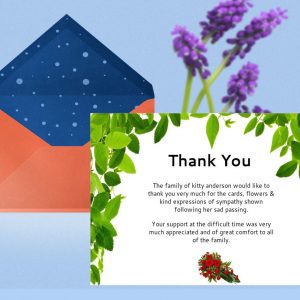Sending a sympathy thank you card is a thoughtful way to express gratitude to those who supported you during a difficult time of loss. Selecting the right salutation can set the tone for the heartfelt message you want to convey. In this guide, we’ll explore various salutation ideas for sympathy thank you cards and provide tips for crafting a meaningful and personalized note.
Why the Right Salutation Matters
The salutation is the opening line of your sympathy thank you card and creates the first impression. It sets the tone for the message that follows and reflects the nature of your relationship with the recipient.
Choosing the Appropriate Salutation
When selecting a salutation, consider the following:
- The Relationship with the Recipient: Close friends, family members, or acquaintances may require different levels of formality.
- Tone of Your Message: Decide if you want the note to feel formal, casual, or deeply personal.
- Cultural and Personal Norms: Some people may prefer traditional or religious tones in the salutation.
Formal Salutations
Formal salutations are suitable for acquaintances, colleagues, or people you may not know personally but wish to thank.
Examples of Formal Salutations
- Dear Mr./Mrs. [Last Name]:
Ideal for professional relationships or individuals you respect deeply. - Dear [Full Name]:
A safe choice when addressing someone you know but aren’t closely acquainted with. - To the [Last Name] Family:
A respectful way to address an entire family. - Dear Friends:
A warm yet formal approach for a group or organization.
When to Use Formal Salutations
- Expressing gratitude to colleagues or professional acquaintances.
- Writing to someone you have not interacted with personally.
Casual Salutations
Casual salutations work well for close friends, family, or anyone you have an informal relationship with.
Examples of Casual Salutations
- Dear [First Name]:
A simple and friendly way to address close friends or relatives. - Hi [Name]:
Suitable for a more relaxed tone, especially for younger recipients. - Hello [Name]:
Polite yet casual, appropriate for friends or neighbors.
When to Use Casual Salutations
- Thanking someone you interact with regularly.
- Writing to a person you feel comfortable addressing informally.
Religious and Spiritual Salutations
If you know the recipient holds religious or spiritual beliefs, incorporating faith-based salutations can add a comforting touch.
Examples of Religious Salutations
- Dear Brother/Sister in Christ:
Perfect for members of your religious community. - Dear [Name], God Bless You:
Combines personal warmth with a spiritual element. - To the Faithful [Last Name] Family:
Acknowledge the recipient’s faith in a respectful manner.
When to Use Religious Salutations
- Thanking clergy members, spiritual leaders, or fellow worshippers.
- Sending a note to someone who shared religious support during the bereavement period.
Creative and Personalized Salutations
Adding a personal touch to your salutation can make your note even more meaningful.
Examples of Personalized Salutations
- Dear Aunt [Name]:
Personalize with the recipient’s specific relationship to you. - To Our Beloved [Name]:
Perfect for family members or close friends. - Dear [Nickname]:
Adds a warm, intimate touch for someone very close.
When to Use Personalized Salutations
- Writing to someone with whom you share a unique bond.
- Crafting a heartfelt note for close family or friends.
Tips for Crafting the Perfect Salutation
Be Mindful of Cultural Sensitivities
Some cultures have specific traditions regarding communication during bereavement. Tailoring your salutation to align with these customs demonstrates thoughtfulness.
Keep It Simple
A short and straightforward salutation often works best, especially if you’re unsure of the recipient’s preferences.
Match the Tone to the Message
Ensure your salutation aligns with the tone of the thank you note. For example, a deeply emotional message pairs well with a warm, personal salutation.
Examples of Complete Sympathy Thank You Notes
Example 1: Formal Note
Salutation:
Dear Mr. and Mrs. Smith,
Message:
Thank you for your kind words and support during this difficult time. Your thoughtfulness brought comfort to our family, and we deeply appreciate your presence at the service.
Sincerely,
The Johnson Family
Example 2: Casual Note
Salutation:
Hi Emily,
Message:
Your kind gesture meant the world to us. Thank you for the delicious meal you brought over; it made a tough week a little easier. We’re so grateful for friends like you.
Warm regards,
Sarah
Example 3: Religious Note
Salutation:
Dear Brother John,
Message:
Your prayers and support have been a source of strength for our family. We are grateful for the love and faith you’ve shared with us. May God bless you abundantly.
With gratitude,
The Carter Family
Funeral Thank You Card Templates
-
Searching for a Simple Funeral Thank You Card Template that is easy to print and amass and that has a cutting-edge look? This Simple Funeral Thank You Card Template is the Perfect decision that is having a measure of 8.5”x 5.5”.
- No Limitation on Content, Edit anything
- Edit anytime – unlimited revisions even after purchased
- Get printable PDF downloaded to get it printed your own.
-
Searching for a Green Leaf Thank You Card template that is easy to print and amass and that has a cutting-edge look? This Green Leaf Thank You Card Template is the Perfect decision that is having a measure of 5.5”x 8.5”.
- No Limitation on Content, Edit anything
- Edit anytime – unlimited revisions even after purchased
- Get printable PDF downloaded to get it printed your own.
-
Searching for a Natural Thank You Card Template that is easy to print and amass and that has a cutting-edge look? This Natural Thank You Card Template is the Perfect decision that is having a measure of 5.5”x 8.5”.
- No Limitation on Content, Edit anything
- Edit anytime – unlimited revisions even after purchased
- Get printable PDF downloaded to get it printed your own.
-
Searching for a Pink Rose Thank You Card Template that is easy to print and amass and that has a cutting-edge look? This Pink Rose Thank You Card Template is the Perfect decision that is having a measure of 5.5”x 8.5”.
- No Limitation on Content, Edit anything
- Edit anytime – unlimited revisions even after purchased
- Get printable PDF downloaded to get it printed your own.
-
Searching for a Autumn Thank You Card Template that is easy to print and amass and that has a cutting-edge look? This Autumn Thank You Card Template is the Perfect decision that is having a measure of 5.5”x 8.5”.
- No Limitation on Content, Edit anything
- Edit anytime – unlimited revisions even after purchased
- Get printable PDF downloaded to get it printed your own.
-
Searching for a Floral Thank You Card Template that is easy to print and amass and that has a cutting-edge look? This Floral Thank You Card Template is the Perfect decision that is having a measure of 5.5”x 8.5”.
- No Limitation on Content, Edit anything
- Edit anytime – unlimited revisions even after purchased
- Get printable PDF downloaded to get it printed your own.
-
Searching for a Irish Green Thank You Card Template that is easy to print and amass and that has a cutting-edge look? This Irish Green Thank You Card Template is the Perfect decision that is having a measure of 5.5”x 8.5”.
- No Limitation on Content, Edit anything
- Edit anytime – unlimited revisions even after purchased
- Get printable PDF downloaded to get it printed your own.
Funeral Programs : Helping Videos
Frequently Asked Question On Salutation For Sympathy Thank You Card
What is the best way to address a group in a sympathy thank you card?
Use collective terms like “Dear Friends” or “To the [Last Name] Family” to address a group respectfully.
Can I use a nickname in the salutation?
Yes, if the recipient is someone close to you and would appreciate the personal touch.
Should I always use “Dear” in a sympathy thank you card salutation?
While “Dear” is traditional and widely accepted, other options like “Hi” or “Hello” may be appropriate for casual notes.








